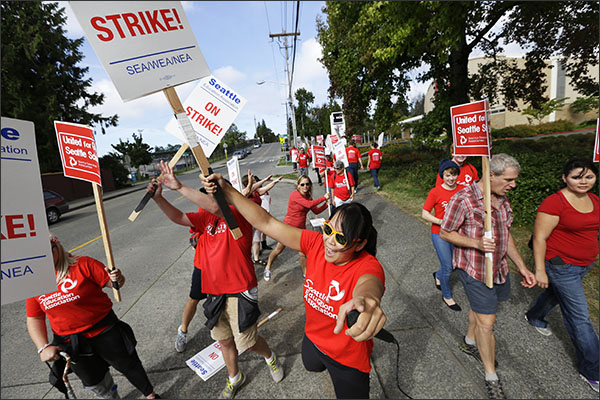Yesterday, The Seattle Times featured an editorial claiming Seattle’s $15 wage law a success simply because the sky hasn’t fallen on the city’s economy.
Ignoring the very clear conclusion of the University of Washington report that was commissioned by the city to study the impacts of the wage law, the authors of the editorial giddily describe what seems like a low-wage worker’s utopian paradise. They say as a result of Seattle’s $15 wage law, workers are earning more, existing businesses are thriving, new businesses are opening and the economy is growing. According to the editorial, the UW study shows the city’s wage law has been an unmitigated success thus far.
Except that’s not what the UW study concludes at all.
Yes, some workers are earning more. Yes, many businesses are doing well and new businesses are opening. Yes, the city’s economy is growing and job growth is healthy.
What the UW study concludes, however, is that things could be even better for Seattle workers without the minimum wage law.
For example, those workers’ gains in earnings have been mostly offset by reduced hours as employers try to mitigate their higher labor costs:
“The major conclusion one should draw from this analysis is that the Seattle Minimum Wage Ordinance worked as intended by raising the hourly wage rate of low-wage workers, yet the unintended, negative side effects on hours and employment muted the impact on labor earnings.”
What is more, the study found most of those earnings gains of low-wage workers would have happened even if the city’s minimum wage had not increased, thanks to the city’s hot economy:
“Most if not all of this gain in quarterly earnings can be explained by the robust economy rather than the Minimum Wage Ordinance.”
So workers would have earned more without the wage hike, and they would not have suffered the side effect of reduced hours. No mention of that in the editorial.
And while business openings did increase, they was actually very little net gain in new businesses because they were almost entirely offset by an increase in business closures. The UW researchers say this increase in both business openings and closures is to be expected:
“A higher minimum wage changes the type of business that can succeed profitably in Seattle, and we should thus expect some extra churning…minimum wage laws prompt increases in both entries and exits (particularly in chains), with closures coming from more labor intensive industries and establishments, and more openings occurring in more capital intensive industries.”
As for Seattle’s economy and job growth, it certainly has grown and jobs have been created, but the UW researchers stress that growth has nothing to do with the city’s $15 minimum wage law:
“We caution against interpreting Seattle’s boom in job growth as an outcome of the Minimum Wage Ordinance. There are clearly other stories to be told about the impressive run of job growth in Seattle: large businesses are adding high-salary jobs [tech sector employment] at an impressive rate, and opportunities in industries such as construction are plentiful in a City enjoying population growth.”
Throughout the editorial, the authors make a series of purposefully misleading statements claims that, while not technically untrue, omit the important conclusions of the UW study. These omissions allow the authors to foster a completely inaccurate portrayal of what the UW study really said. Let’s take a look at a few more.
The editorial declares a previous study by the UW researchers found no evidence of price increases in the retail industry. What the authors neglect to mention is that same study found prices in the restaurant industry, which rely heavily on minimum wage workers, have increased significantly. According to the study, prices at fast food establishments, coffee shops and full service restaurants are an average of 9% higher than just a year ago. The head of the UW research team explains this is not surprising given the labor-intensive nature of the food service industry versus retail.
The editorial claims the wage hike has raised the floor for workers and families. It completely ignores the UW study findings that workers and families are doing even better in other regions in the state whose economies are not nearly as hot as Seattle’s. That’s right, despite the wage hike, the UW study found workers in Seattle are “lagging behind” their low-wage counterparts in regions of the state that don’t have the benefit of a booming economy:
“While 2015 was a good year for the group of Seattle workers we track, it was an even better year for the workers employed in [other regions of the state].”
The editorial’s authors boast that the employment rate of low-wage workers in Seattle has increased; they left out the part of the UW study that found the employment rate of similar workers in other parts of the state increased even more. In comparison, the UW researchers conclude Seattle’s minimum wage “appears to have lowered employment rates of low-wage workers.”
Of course, the authors of the editorial dismiss the UW researchers’ comparison of Seattle to other regions of the state, criticizing the study’s methodology and downplaying the results. They say the comparison the study “attempted” is, in their expert opinion, neither representative nor relevant to Seattle. Never mind that the methodology used by the researchers in the UW study “uses widely accepted statistical techniques.”
The goal of the UW study was to assess whether low-wage workers in Seattle are better off today than they would have been if the city had not adopted a higher minimum wage. The results indicate the answer to that question, at least so far, is no.
Little wonder the authors of the editorial would prefer a more simplistic, and less comprehensive, comparison of the wages earned and hours worked in Seattle before the wage law went into effect and today. The UW researchers say such a “simple before/after comparison” does not answer the question that tells the real story—how would workers be doing if Seattle had not passed the $15 wage law?
Nevertheless, the authors insist this simple comparison tells “the story that really matters.”
They are wrong. What really matters is whether Seattle’s minimum wage law is helping low-wage workers in the city. Based on the findings of the UW study, had the city not passed its minimum wage law, low-wage workers would be earning nearly as much, but would not be suffering the side-effects of reduced hours and employment opportunities. As a result, low-wage workers in other areas of Washington are doing better than workers in the city with the hottest economy in the state. It appears Seattle’s minimum wage law is failing the very workers it was supposed to help, and that is the only story that really matters.





